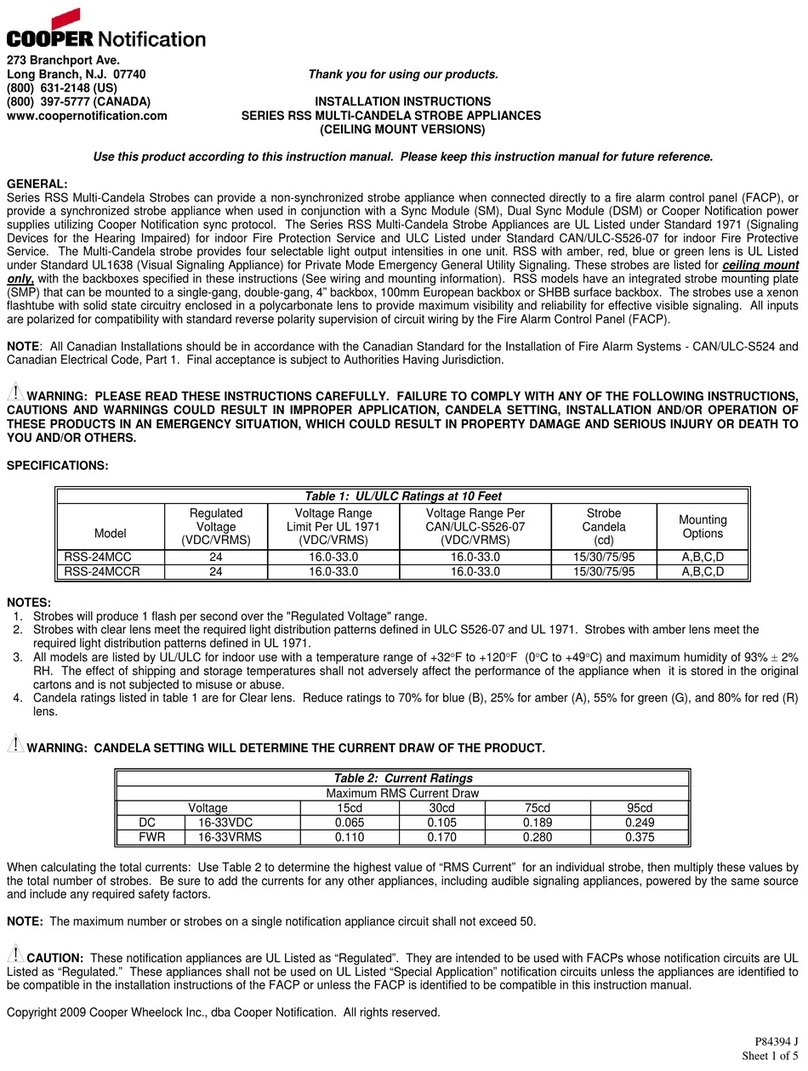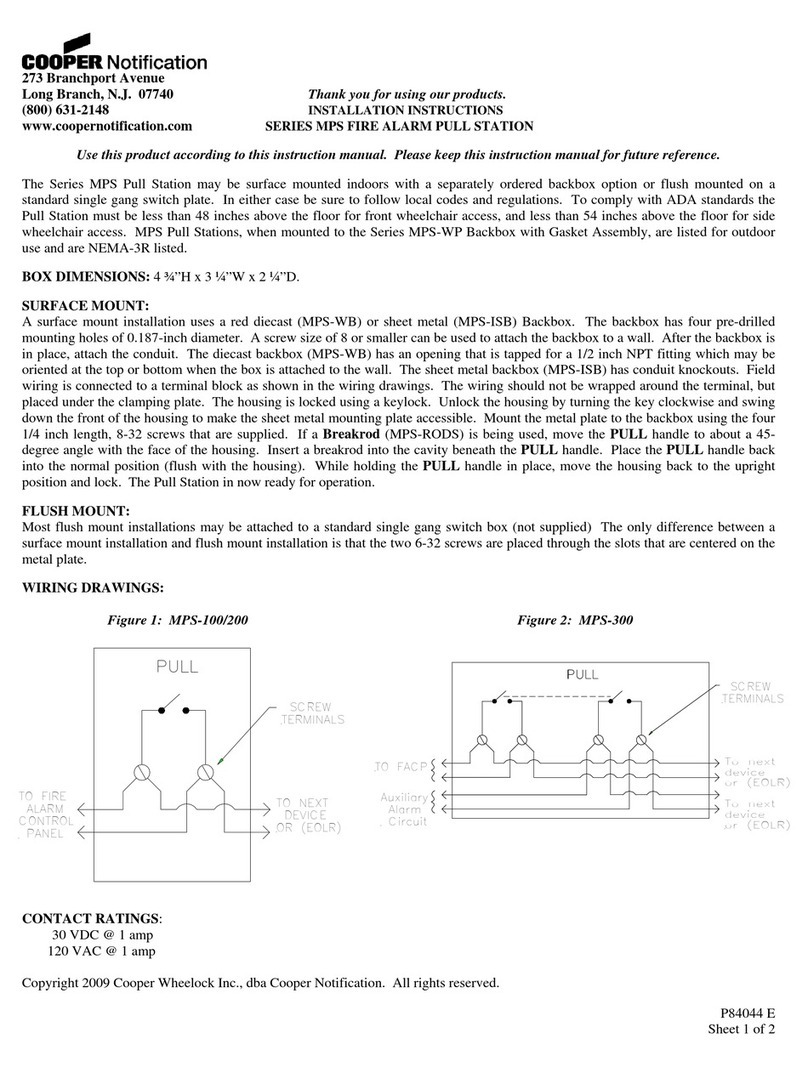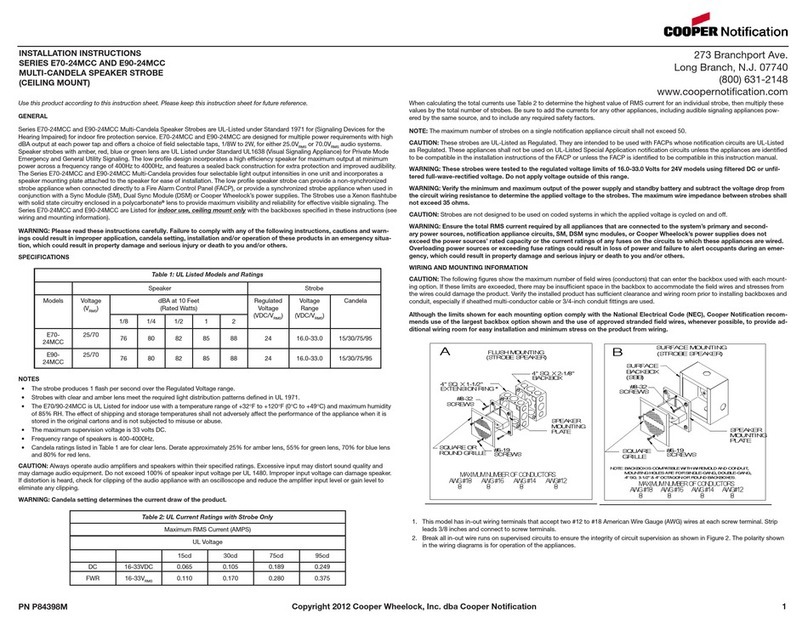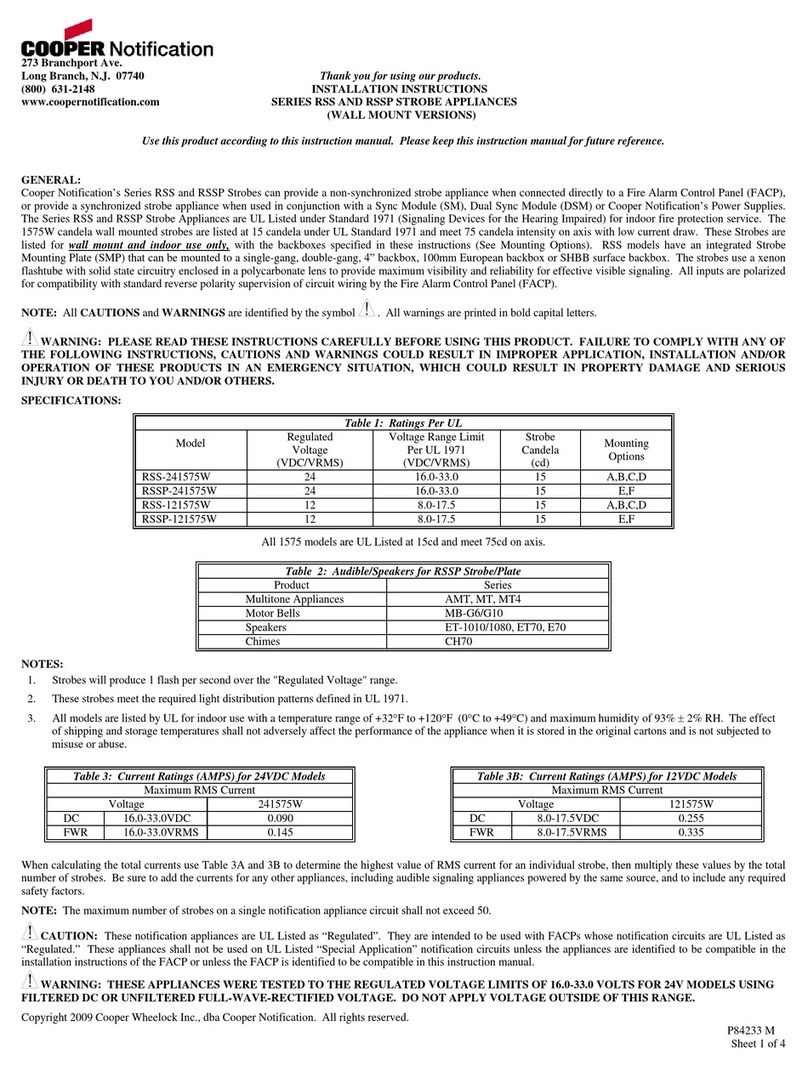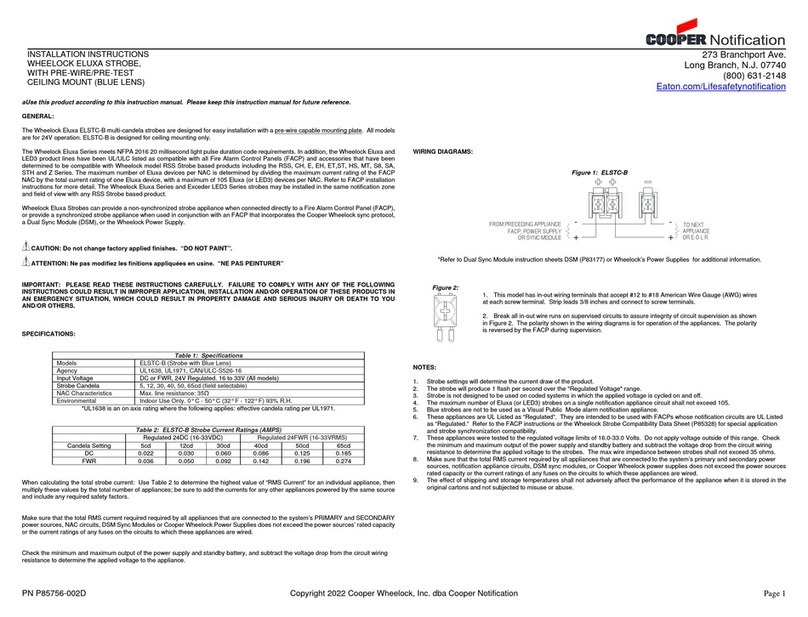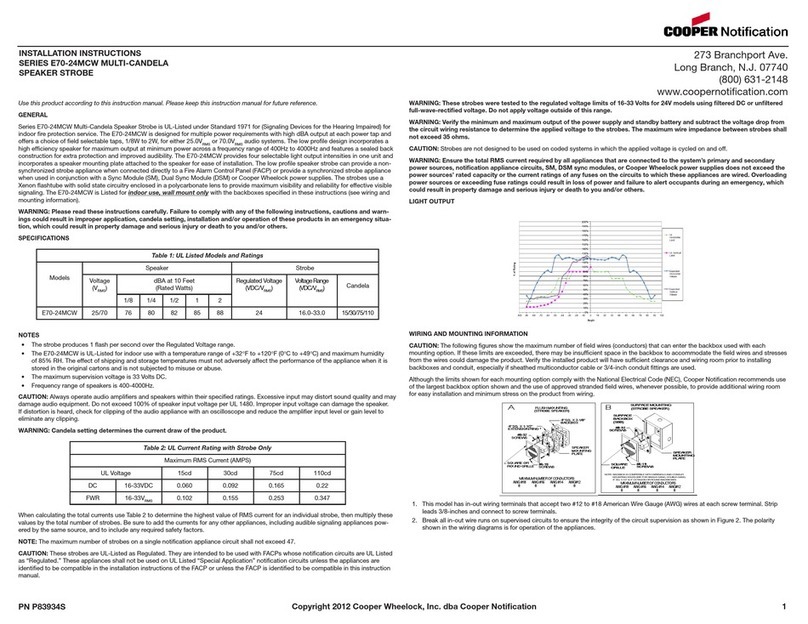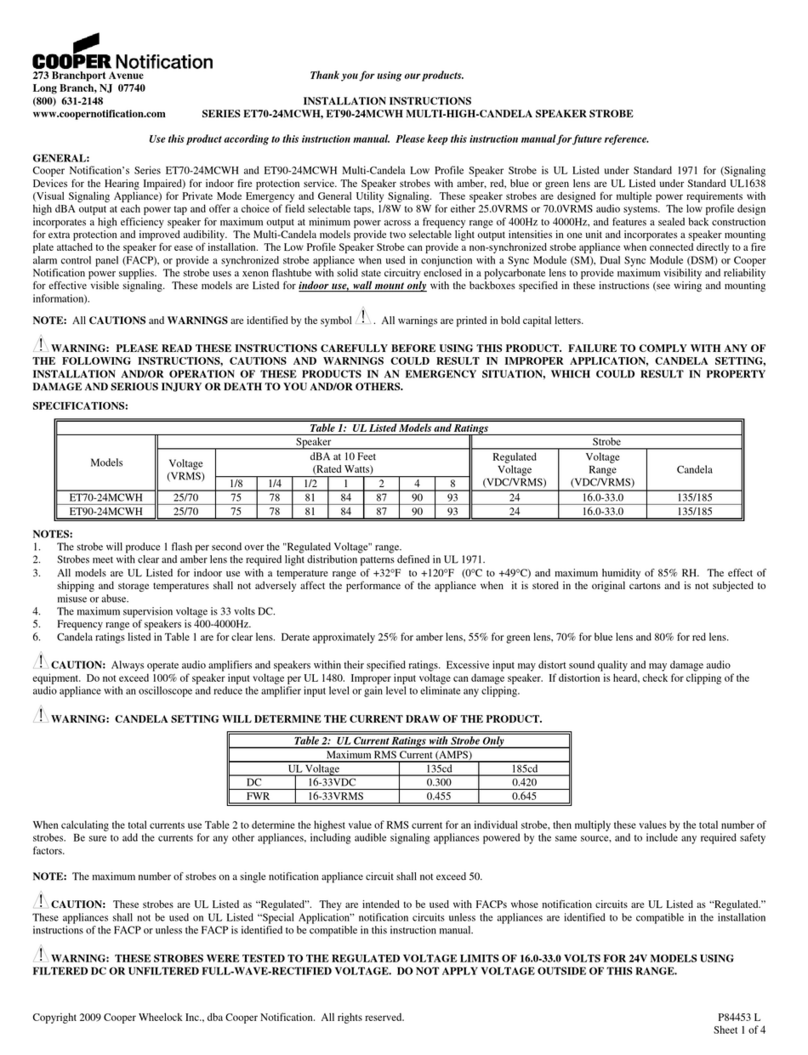
INSTALLATION INSTRUCTIONS
CHIME AND CHIME STROBES
-WIRE/PRE-TEST (WALL MOUNT)
273 Branchport Ave.
Long Branch, N.J. 07740
(800) 631-2148
www.coopernotification.com
PN P85864B Copyright 2022 Cooper Wheelock, Inc. dba Cooper Notification Page 1
Use this product according to this instruction manual. Please keep this instruction manual for future reference.
GENERAL:
The Wheelock Eluxa series ELCH Chime and ELCHS Chime-Strobe appliances are designed for easy installation with a pre-wire capable
mounting plate. All models are for 24V operation. Series ELCH/ELCHS Eluxa Chime is UL Listed for indoor fire protection service under
Standard UL464 for Private Mode Audible Signal Appliances as well as ULC-S525-2016 (Audible Signaling Devices for Fire Alarm and
Signaling Systems). The Eluxa Chime is designed for low current draw and versatile performance. The Eluxa Chime offers a choice of
1Hz, 2Hz, coded, or temporal code 3 (T3) operation. It has an adjustable sound level, and operates at a frequency of 890Hz. The Low
Profile design incorporates a high efficiency speaker for maximum output at minimum power, and features a sealed back construction for
extra protection and improved audibility. These models are listed for indoor use, wall mount with the backboxes specified in these
instructions (see mounting options). Model ELCH (non-strobe) may be wall or ceiling mounted.
The Wheelock Eluxa Series meets NFPA 2016 20 millisecond light pulse duration code requirements. In addition, the Wheelock Eluxa and
LED3 product lines have been UL/ULC listed as compatible with all Fire Alarm Control Panels (FACP) and accessories that have been
determined to be compatible with Wheelock model RSS Strobe based products including the RSS, CH, E, EH, ET,ST,HS,MT,S8, SA, STH
and Z Series. The maximum number of Eluxa devices per NAC is determined by dividing the maximum current rating of the FACP NAC by
the total current rating of one Eluxa device, with a maximum of 105 Eluxa (or LED3) devices per NAC. Refer to FACP installation instructions
for more detail. The Wheelock Eluxa Series and Exceder LED3 Series strobes may be installed in the same notification zone and field of
view with any RSS Strobe based product.
Wheelock Eluxa Strobe can provide a non-synchronized strobe appliance when connected directly to a Fire Alarm Control Panel (FACP),
or provide a synchronized strobe appliance when used in conjunction with an FACP that incorporates the Wheelock Sync Protocol, a Dual
Sync Module (DSM) or a Wheelock Power Supply.
CAUTION: Do not change factory applied finishes. “DO NOT PAINT”.
ATTENTION: Ne pas modifiez les finitions appliquées en usine. “NE PAS PEINTURER”
IMPORTANT: PLEASE READ THESE INSTRUCTIONS CAREFULLY. FAILURE TO COMPLY WITH ANY OF THE FOLLOWING
INSTRUCTIONS COULD RESULT IN IMPROPER APPLICATION, INSTALLATION AND/OR OPERATION OF THESE PRODUCTS IN
AN EMERGENCY SITUATION, WHICH COULD RESULT IN PROPERTY DAMAGE AND SERIOUS INJURY OR DEATH TO YOU
AND/OR OTHERS.
SPECIFICATIONS:
Table 1: Specifications
Agency Strobe: UL1638, UL1971,CAN/ULC-S526-16
Input Voltage DC or FWR, 24V Regulated, 16 to 33V (All models)
Chime Patterns 1Hz, 2Hz, Coded, T3 (field selectable, Table 4)
NAC Characteristics Max. line resistance: 35Ω
Environmental Indoor Use Only. 0°C - 50°C (32°F - 122°F) 93% R.H.
Table 2A: Eluxa Chime – Current and Sound Pressure Level Ratings
Maximum
RMS
Current
Reverberant dBA at 10Ft
per UL464
for Private Mode
Anechoic dBA at 10 Ft
per CAN/ULC-S525-16
for Dwelling Use Only
DC 16.0 – 33.0 Vdc 0.022 51 68 61 78
FWR 16.0 – 33.0 Vrms 0.022 51 68 61 78
Table 2B: Directional Characteristics
-3dB +/- 90 Degrees Horizontal, +/- 90 Degrees Vertical (does not reach 3dB)
Table 3: ELCHS Strobe Current Ratings (AMPS) **
Regulated 24DC (16-33VDC) Regulated 24FWR (16-33VRMS)
Candela Setting 15cd 30cd 75cd 110cd 135cd 185cd
** Setting will determine the current draw of the product.
When calculating the total currents: Use Table 2A and Table 3 to determine the highest value of “RMS Current” for an individual appliance,
then multiply these values by the total number of appliances; be sure to add the currents for any other appliances powered by the same
source and include any required safety factors.
Make sure that the total RMS current required required by all appliances that are connected to the system’s PRIMARY and SECONDARY
power sources, NAC circuits, DSM Sync Modules or Wheelock Power Supplies does not exceed the power sources’ rated capacity or the
current ratings of any fuses on the circuits to which these appliances are wired.
Check the minimum and maximum output of the power supply and standby battery, and subtract the voltage drop from the circuit wiring
resistance to determine the applied voltage to the appliance.
WIRING DIAGRAMS:
Figure 1A: One Circuit. ELCH Chime
+
-
FROM PRECEDING APPLIANCE
FACP, POWER SUPPLY
OR SYNC MODULE
TO NEXT
OR E.O.L.R.
APPLIANCE
+
-
Figure 1B: One circuit.
ELCHS Chime and Strobe activate in unison.
Figure 1C: Two Circuits (Chime may be Coded)
ELCHS Chime and Strobe will operate independently
FROM PRECEDING APPLIANCE
FACP, POWER SUPPLY
OR SYNC MODULE
TO NEXT
OR E.O.L.R.
APPLIANCE
+
-
+
-
FROM PRECEDING APPLIANCE
FACP, POWER SUPPLY
TO NEXT
OR E.O.L.R.
OR SYNC MODULE
FROM PRECEDING APPLIANCE
FACP, POWER SUPPLY
OR SYNC MODULE
APPLIANCE
TO NEXT
OR E.O.L.R.
APPLIANCE
+
-
+
-
+
-
+
-
*Refer to Dual Sync Module instruction sheets DSM (P83177) or Wheelock’s Power Supplies for additional information.
Figure 2:
1. This model has in-out wiring terminals that accept two #12 to #18 American Wire Gauge (AWG) wires at
each screw terminal. Strip leads 3/8 inches and connect to screw terminals.
2. Break all in-out wire runs on supervised circuits to assure integrity of circuit supervision as shown in
Figure 2. The polarity shown in the wiring diagrams is for operation of the appliances. The polarity is
reversed by the FACP during supervision.
NOTES:
1. The strobe will produce 1 flash per second over the "Regulated Voltage" range.
2. Strobe is not designed to be used on coded systems in which the applied voltage is cycled on and off.
3. The maximum number of Eluxa or LED3 strobes on a single notification appliance circuit shall not exceed 105.
4. These appliances are UL Listed as “Regulated”. They are intended to be used with FACPs whose notification circuits are UL Listed
as “Regulated.” Refer to the FACP instructions or the Wheelock Strobe Compatibility Data Sheet (P85328) for special application
and strobe synchronization compatibility.
5. These appliances were tested to the regulated voltage limits of 16.0-33.0 Volts. Do not apply voltage outside of this range. Check
the minimum and maximum output of the power supply and standby battery and subtract the voltage drop from the circuit wiring
resistance to determine the applied voltage to the strobes. The max wire impedance between strobes shall not exceed 35 ohms.
6. Make sure that the total RMS current required by all appliances that are connected to the system’s primary and secondary power
sources, notification appliance circuits, DSM sync modules, or Wheelock power supplies does not exceed the power sources rated
capacity or the current ratings of any fuses on the circuits to which these appliances are wired.
7. The Code 3 temporal pattern (1/2 second on, 1/2 second off, 1/2 second on, 1/2 second off, 1/2 second on, 1-1/2 off and repeat) is
specified by ANSI and NFPA 72 for standard emergency evacuation signaling. Code 3 shall be used only for fire evacuation signaling
and not for any other purpose.
8. The effect of shipping and storage temperatures shall not adversely affect the performance of the appliance when it is stored in the
original cartons and not subjected to misuse or abuse.
